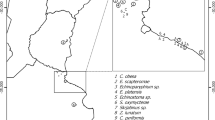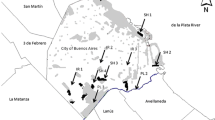Abstract
In the present study, two abundant sympatric rodent species (27 Apodemus flavicollis and 33 A. sylvaticus) were studied for their endo- and ectoparasite fauna. The rodents were trapped in Dormagen, a city in North Rhine–Westphalia, Germany. A total of 20 different parasites species were identified, 13 endoparasite (2 Digenea, 5 Cestoda and 7 Nematoda) and 7 ectoparasite (5 Insecta and 2 Arachnida) species. Thirteen parasite species were found inhabiting both rodent species. The predominant endoparasite species in both rodents was the nematode Pelodera strongyloides, followed by the nematode Heligmosomoides polygyrus and a Syphacia species. The flea Ctenophthalmus agyrtes was the dominant ectoparasite in both rodent species. A. flavicollis usually carried 1–7 ecto-/endoparasite species (mean 4.0), whereas A. sylvaticus were mostly infested with 1–9 (mean 4.4). The parasite diversity of A. flavicollis (H′ = 0.268, J = 0.097) was marginal lower in comparison to A. sylvaticus (H′ = 0.319, J = 0.110). The two rodent species examined show remarkable similarities in the composition of their endo- and ectoparasite fauna being directly related to their similar pattern of living in the investigated area.





Similar content being viewed by others
References
Anderson RC (2000) Nematode parasites of vertebrates. Their development and transmission. CAB International, Wallingford
Ashour AA, Wannas MQ, el-Alfy NM, Salama MM, Arafa MA, Abdel Mawla MM, Morsy TA (1994) Scanning electron microscopy of Capillaria muris sylvatici from Clethrionomys glareolus with reference to zoonotic species. J Egypt Soc Parasitol 24:663–670
Behnke JM, Lewis JW, Mohd Zain SN, Gilbert FS (1999) Helminth infection in Apodemus sylvaticus in southern England: interactive effects of host-age, sex and year on prevalence and abundance of infections. J Helminthol 73:31–44
Behnke JM, Barnard CJ, Bajer A, Bray D, Dinmore J, Frake K, Osmond J, Race T, Sinski E (2001) Variation in the helminth community structure in bank voles (Clethrionomys glareolus) from three comparable localities in the Mazury District region in Poland. Parasitology 123:401–414
Benz GW (1995) Biodiversity: Are we neglecting half of earth’s fauna? Proceedings of the third international aquarium congress. Boyd, Wheeling
Bray JR, Curtis JT (1957) An ordination of the upland forest communities of Southern Wisconsin. Ecol Monogr 27:325–349
Bush O, Lafferty AD, Lotz JM, Shostak AW (1997) Parasitology meets ecology on its own terms: Margolis et al. revisited. J Parasitol 83:575–583
Cheng TC (1986) General parasitology. Academic, New York
Dawes B (1968) The Trematoda—with special references to British and other European forms. Cambridge University Press, London
Faulde M, Hoffmann G (2001) Vorkommen und Verhütung vektorassoziierter Erkrankungen des Menschen in Deutschland unter Berücksichtigung zoonotischer Aspekte. Bundesgesundheitsbl-Gesundheitsforsch-Gesundheitsschutz 44:116–136
Feliu C, Renaud F, Catzeflis F, Hugot JP, Durand P, Morand S (1997) A comperative analysis of parasite species richness of Iberian rodents. Parasitology 115:453–466
Ferrari N, Cattadori IM, Nespereira J, Rizzoli A, Hudson PJ (2003) The role of host sex in parasite dynamics: field experiments on the yellow-necked mouse Apodemus flavicollis. Ecol Lett 6:1–7
Field JG, Clarke KR, Warwick RM (1982) A practical strategy for analyzing multispecies distribution patterns. Mar Ecol Prog Ser 8:37–52
Fuentes MV, Sáez S, Trelis M, Galàn-Puchades MT, Esteban JG (2004) The helminth community of Apodemus sylvaticus (Rodentia, Muridae) in the Sierra Espuña, Murcia, Spain. J Helminthol 78:219–233
Holmes JC, Price PW (1980) Parasite communities: the roles of phylogeny and ecology. Syst Zool 29:203–213
Hominick WM, Aston AJ (1981) Association between Pelodera strongyloides (Nematoda: Rhabditidae) and wood mice, Apodemus sylvaticus. Parasitology 83:67–75
Karg W (1994) Raubmilben, nützliche Regulatoren im Naturhaushalt: Lebensweise, Artbestimmung und Nutzung. In: Die Neue Brehm-Bücherreihe, Bd. 624; Westarp-Wiss., Magdeburg
Klimpel S, Seehagen A, Palm HW (2003) Metazoan parasites and feeding behaviour of four small-sized fish species from the central North Sea. Parasitol Res 91:290–297
Klimpel S, Palm HW, Busch MW, Kellermanns E, Rückert S (2006) Fish parasites in the Arctic deep-sea: poor diversity in pelagic fish species vs. heavy parasite load in a demersal fish. Deep Sea Res Pt I 53:1167–1181
Krasnov BR, Morand S, Hawlena H, Khokhlova IS, Shenbrot GI (2005) Sex-based parasitism, seasonality and sexual size dimorphism in desert rodents. Oecologia 146:209–217
Kruskal JB (1964) Multidimensional scaling by optimising goodness of fit to a non-metric hypothesis. Psychometrika 29:1–27
Kruskal JB, Wish M (1978) Multidimensional Scaling. Sage, Beverly Hills, CA
Lewis JW (1968) Studies on the helminth parasites of the long-tailed field mouse, Apodemus sylvaticus from Wales. J Zool Lond 154:287–312
Lewis JW (1987) Helminth parasites of British rodents and insectivores. Mamm Rev 17:81–93
Lewis RE (1993) Fleas (Siphonaptera). In: Lane RP, Crosskey RW (eds) Medical insects and arachnids. Chapman & Hall, London, pp 529–575
Lile NK (1998) Alimentary tract helminths of four pleuronectid flatfish in relation to host phylogeny and ecology. J Fish Biol 53:945–953
Lucius R, Böckeler W, Pfeiffer AS (1988) Parasiten der Haus-, Nutz- und Wildtiere Schleswig-Holsteins: Parasiten der inneren Organe des Rotfuchses (Vulpes vulpes). Z Jagdwiss 34:242–255
Magurran AE (1988) Ecological diversity and its measurement. Croom Helm, London
Martin Y, Gerlach G, Schlötterer C, Meyer A (2000) Molecular phylogeny of european muroid rodents based on complete cytochrome b sequences. Mol Phylogenet Evol 16:37–47
Memaran M (1970) Die Helminthenfauna der Waldmaus (Apodemus sylvaticus L.), der Gelbhalsmaus (Apodemus flavicollis Melchior) und der Rötelmaus (Clethrionomys glareolus Schreber) im Naturpark Hoher Vogelsberg. PhD-Thesis, University Gießen
Muñoz G, Grutter AS, Cribb TH (2006) Endoparasite communities of five fish species (Labridae: Cheilininae) from Lizard Island: how important is the ecology and phylogeny of the hosts? Parasitology 132:363–374
Peus F (1972) Zur Kenntnis der Flöhe Deutschlands. Zool Jb Syst 97:408–504
Reutter BA, Petit E, Brünner H, Vogel P (2003) Cytochrome b haplotype divergences in West European Apodemus. Mamm Biol 68:153–164
Riemann F (1988) Nematoda. In: Higgins RP, Thiel H (eds) Introduction to the study of meiofauna. Smithsonian Institution, Washington, DC
Saari SAM, Nikander SE (2006) Pelodera (syn. Rhabditis) strongyloides as a cause of dermatitis—a report of 11 dogs from Finland. Acta Vet Scand 48:1–7
Serizawa K, Suzuki H, Tsuchiya K (2000) A phylogenetic view on species radiation in Apodemus inferred from variation of nuclear and mitochondrial genes. Biochem Genet 38:27–40
Skrjabin KI, Shikhobalova NP, Orlov IV (1957) Trichostrongyloidae and capillariidae of animals and man and the diseases caused by them. In: Skrjabin KI (ed) Essentials of nematology, vol. VI, Academy of Science of the USSR. (Israel Program for Scientific Translations, Jerusalem 1970)
Świderski Z, Salamatin RV, Grytner-Ziẹcina B, Kornyushin VV, Conn DB (2004) Electron microscope study on oncospheral envelope morphogenesis in the dilepidid cestode, Dilepis undula (Schrank, 1788). Acta Parasitol 49:300–308
Visser M, Rehbein S, Wiedemann C (2001) Species of flea (Siphonaptera) infesting pets and hedgehogs in Germany. J Vet Med B Infect Diss Vet Public Health 48:197–202
Author information
Authors and Affiliations
Corresponding author
Rights and permissions
About this article
Cite this article
Klimpel, S., Förster, M. & Schmahl, G. Parasites of two abundant sympatric rodent species in relation to host phylogeny and ecology. Parasitol Res 100, 867–875 (2007). https://doi.org/10.1007/s00436-006-0368-8
Received:
Accepted:
Published:
Issue Date:
DOI: https://doi.org/10.1007/s00436-006-0368-8




